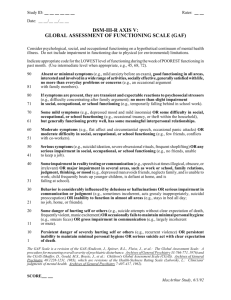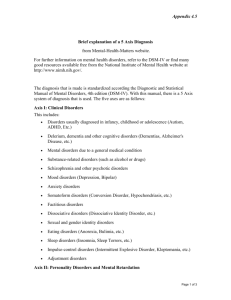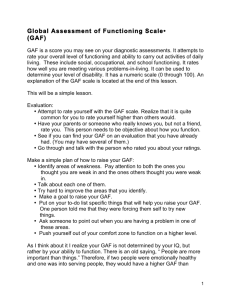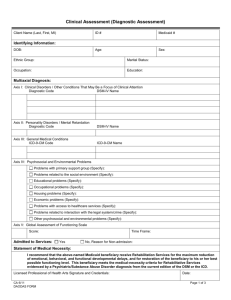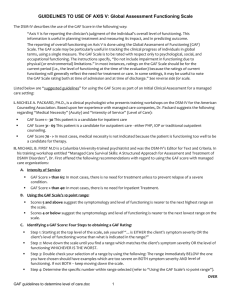Global Assessment of Functioning (GAF) Scale
advertisement
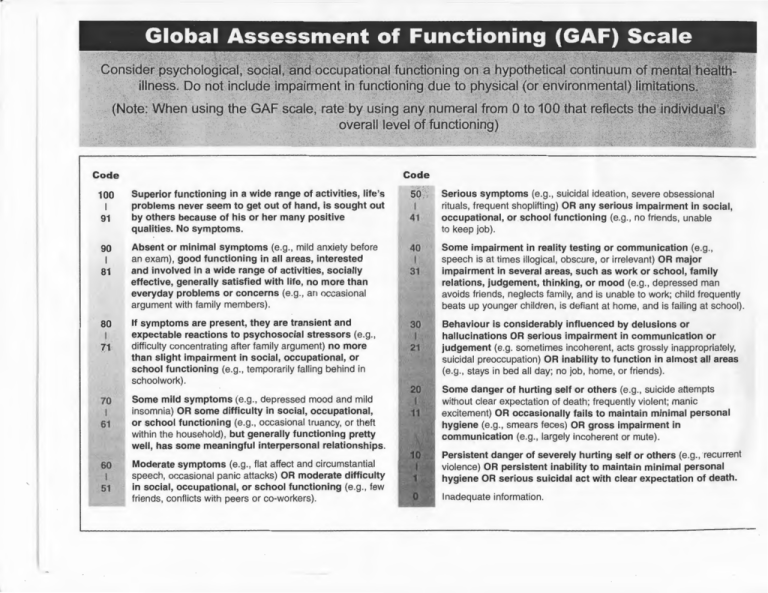
Global Assessment of Functioning (GAF) Scale I "" . ·-•- '··. _.,- .·- ···"-· - Consider psychological, social, and occupational functioning on a hypothetical continuum ofnientallie~l_th­ illness. Do not include impairment in functioning due to physical (or environmental) limitations. (Note: When using the GAF scale, rate .by using any numeral from 0 to 100 that reflects the individual'$ _- · . overall level of functioning) Code Code 100 1 91 Superior functioning in a wide range of activities, life's problems never seem to get out of hand, is sought out by others because of his or her many positive qualities. No symptoms. 50 I 41 Serious symptoms (e.g., suicidal ideation, severe obsessional rituals, frequent shoplifting) OR any serious impairment in social, occupational, or .school functioning (e.g., no friends, unable to keep job). 90 1 81 Absent or minimal symptoms (e.g., mild anxiety before an exam), good functioning in all areas, interested and involved in a wide range of activities, socially effective, generally satisfied with life, no more than everyday problems or concerns (e.g., an occasional argument with family members). Some impairment in reality testing or communication (e.g., speech is at times illogical, obscure, or irrelevant) OR major impairment in several areas, such as work or school, family relations, judgement, thinking, or mood (e.g., depressed man avoids friends, neglects family, and is unable to work; child frequently beats up younger children, is defiant at home, and is failing at school). 80 1 71 If symptoms are present, they are transient and expectable reactions to psychosocial stressors (e.g., difficulty concentrating after family argument) no more than slight impairment in social, occupational, or school functioning (e.g., temporarily falling behind in schoolwork). Behaviour is considerably influenced by delusions or hallucinations OR serious impairment in communication or judgement (e.g. sometimes incoherent, acts grossly inappropriately, suicidal preoccupation) OR inability to function in almost all areas (e.g., stays in bed all day; no job, home, or friends). 70 1 61 Some mild symptoms (e.g., depressed mood and mild insomnia) OR some difficulty in social, occupational, or school functioning (e.g., occasional truancy, or theft within the household}, but generally functioning pretty well, has some meaningful interpersonal relationships. 60 1 Moderate symptoms (e.g., flat affect and circumstantial ' speech, occasional panic attacks) OR moderate difficulty i in social, occupational, or school functioning (e.g ., few friends, conflicts with peers or co-workers). 51 Some danger of hurting self or others (e.g., suicide attempts without clear expectation of death; frequently violent; manic excitement) OR occasionally fails to maintain minimal personal hygiene (e.g., smears feces) OR gross impairment in communication (e.g., largely incoherent or mute). Persistent danger of severely hurting self or others (e.g., recurrent violence) OR persistent inability to maintain minimal personal hygiene OR serious suicidal act with clear expectation of death. Inadequate information. DSM-IV Multiaxial System • Disorders usually first diagnosed in infancy, childhood, or adolescence (excluding mental retardation , which is diagnosed on Axis II) • Delirium, dementia and amnestic and other cognitive disorders • Mental disorders due to a general medical condition • Substance-related disorders • Schizophrenia and other psychotic disorders • Mood disorders • Anxiety disorders • Somatoform disorders • Factitious disorders • Dissociative disorders • Sexual and gender identity disorders • Eating disorders • Sleep disorders • Impulse-control disorders not elsewhere classified • Adjustment disorders Axis II f t ·; • Infectious and parasitic diseases • Neoplasms • Endocrine, nutritional and metabolic diseases and immunity disorders • Diseases of the blood and blood-forming organs • Diseases of the nervous system sense organs • Diseases of the circulatory system • Diseases of the respiratory system • Diseases of the digestive system • Diseases of the genitourinary system • Complications of pregnancy, childbirth and the puerperium • Diseases of the skin and subcutaneous tissue • Diseases of the musculoskeletal system and connective tissue • Congenital anomalies • Certain conditions originating in the perinatal period • Symptoms, signs, and ill-defined conditions • Injury and poisoning Axis IV ~ ~ Axis V is for reporting the clinician's judgment of the individual's overall level of functioning. This information is useful in planning treatment and measuring its impact and in predicting outcome. The reporting of overall functioning on Axis V can be done using the Global Assessment of Functioning (GAF) Scale. The GAF Scale can be particularly useful in tracking the clinical progress of individuals in global terms, using a single measure. The GAF Scale is to be rated with respect only to psychosocial, social, and occupational functioning. The instructions specify, "Do not include impairment in functioning due to physical (or environmental) limitations." In most instances, ratings on the GAF Scale should be for the current period (i.e., the level of functioning at the time of the evaluation) because ratings of current functioning will generally reflect the need for treatment or care. In • Paranoid personality disorder • Schizoid personality disorder • Schizotypal personality disorder • Antisocial personality disorder • Borderline personality disorder • Histrionic personality disorder • Narcissistic personality disorder • Avoidant personality disorder • Dependent personality disorder • Obsessive compulsive personality disorder • Personality disorder not otherwise specified • Mental retardation some settings, it may be useful to note the GAF Scale • Problems with primary support group • Problems related to the social environment • Educational problems • Occupational problems • Housing problems • Economic problems • Problems with access to health care services • Problems related to interaction with the legal system/crime • Other psychosocial and environmental problems rating both at time of admission and at time of discharge. The GAF scale may also be rated for other time periods (e.g. , the highest level of functioning for at least a few months during the past year). The GAF Scale is reported on Axis V as follows: "GAF= ," followed by the GAF rating from 0 to 100, followed by the time period reflected by the rating in parentheses- for example "(current)': "(highest level in past year)", "(at discharge)".

